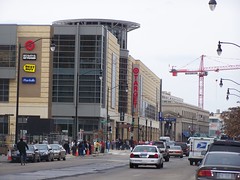What is the second act for retail in Columbia Heights?
I have been thinking about this for a bit, and then on the columbia_heights e-list there was a suggestion that the headquarters for the real estate analysis firm, Co-Star, be located there (see "DC Council backs controversial tax breaks to lure 2 firms" from the Post).
So I wrote (2 emails combined into one here):
Maybe it would, maybe it wouldn't. Sure, any incremental addition of people helps,especially during the day when retail districts often languish . But recognize that office workers support a very limited amount of commercial space.
The industry rule of thumb is 2 s.f. of retail and 5 s.f. of casual restaurant/take out space per worker, and the type of retail supported is very limited, usually convenience retail like CVS. Note as examples the relatively limited retail offerings in office districts such as M Street SE or Crystal City in Arlington.
So 1,000 workers support !!!!!!2,000 s.f. of retail space !!!!!!!!!!!!!!! and !!!!!!!!!!!! 5,000 s.f. !!!!!!!!!!!! of restaurant space.
So don't get too worked up about it. (And it's why chasing office development with big TIF exemptions can be a losing game, except for the property tax revenue, and some income tax revenue. BUT IT STILL PISSES ME OFF YEARS LATER, how immediately after the property tax exemption for Bureau of National Affairs expired, that they decamped for Arlington County. That's why _every_ property tax exemption of this nature should have massive clawback provisions, among other protections to ensure that there is acceptable civic and public finance ROI from such actions.)
One of the things I have been thinking about lately is that the Columbia Heights retail revitalization program has no second act.
While I was wrong, admittedly, in not favoring the creation of a chain retail center there (although I was right, in 2004-2005 to oppose the funding of a huge parking garage in the project since it is atop _the subway_), I think that DC/USA is a big success (at the very least I shop there, lugging items like Slow Cookers from Target on my bicycle), and is helpful in retaining consumer sales of DC residents thereby generating sales tax dollars, adding shopping options, and as repositioning Columbia Heights as a regional retail destination, even if the scale of "regional" in this instance is within DC only.
In and of itself, DC/USA doesn't provide enough retail to attract non residents. And given that what is offered is mostly convenience and/or discount goods, with the exception of Best Buy, it ends up being a limited offering.
The Reilly Law of Retail Gravitation is mathematical, but I summarize it thusly: with transportation costs being roughly equal, people choose to shop at the place with more and better stores.
For those of us in upper NW DC, comparing Columbia Heights to Silver Spring (has a Borders, movie theaters, more restaurants, Ulta [a cosmetics store that my wife frequents], great hardware store, some clothing shops, Whole Foods) or Bethesda (Bethesda Row has theaters, mostly restaurants, specialty shops, and Barnes & Noble), if we are "good little consumers" a la the Reilly Law, we will choose those Montgomery County locations, because foremost we are concerned about efficiency.
Another good comparison would be Columbia Heights to the DC side of Friendship Heights, with Mazza Gallery, admittedly an upscale mall, and the shopping center across the street, which includes not just Cheesecake Factory but stores like Pottery Barn, J. Crew, Borders, World Market, and Loehmann's. Plus there is other retail on the next couple blocks south, and the Lord & Taylor in back of Mazza Gallery. Plus then there is the additional retail on the Maryland side, ranging from high upscale (Saks) to the Gap and a Giant Supermarket and a Clyde's Restaurant.
Columbia Heights is pretty landlocked with limited opportunity for additional commercial redevelopment, and not able to add much in the way of additional chain retail with the space available at this time (with the current planning regime in place).
Clearly, if the Columbia Heights retail district is to extend its place within the regional retail landscape, it needs to add specialty goods stores, particularly in apparel, but other categories as well. Don't think about this comparison in terms of chain marques specifically, but about the breadth and type of the offering in the shopping district as a whole.
And then think about Columbia Heights and how to develop a retail plan and strategy along those lines.
I'd be focusing on that, and not on Co-Star.
--------
Disclosure: I was part of a bidding team (the RFP was not executed due to funding cutbacks) to do a next stage retail analysis of Columbia Heights. While the RFP excluded the 3100 block of 14th Street (where DC/USA is located), had we won the contract, we would have covered this and other points, basically, how to extend the retail energy that is present with DC/USA and the Giant Supermarket, and how to capitalize on the regional retail center aspects that these stores provide to strengthen the retail offerings north of the 3100 block as well as the secondary shopping district on 13th Street.
Labels: commercial district revitalization, formula retail, retail enterpreneurship development, retail planning




0 Comments:
Post a Comment
<< Home